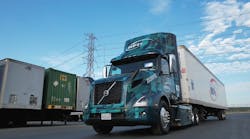I was first introduced to the concept of gemba back in the 1990s. It is a Japanese word that means “the actual place.” The idea of gemba is to go somewhere to see the actual process and learn from those who are doing the work.
While the idea of gemba is usually applied to manufacturing, I think it also can be used more broadly to gain knowledge about a number of things. I particularly see it being applicable to electric trucks.
There are many people in trucking—vehicle manufacturers, battery makers, fleets, companies working on charging infrastructure and managed charging, utilities, et cetera—that are making great strides in the area of electric vehicle deployment in freight-hauling applications.
I think there is a great deal that can be learned from these early adopters, some of whom already have been willing to share what they've learned with the industry as part of Run on Less—Electric.
What we learned during the Run was that the 13 participating fleets traveled 6,900 miles and saved 11.72 tons of CO2. That is pretty impressive, but what is even more impressive is the fact that if the 5.2 million vehicles in the market segments represented by the Run—van/step van, medium-duty box truck, terminal tractor and short heavy tractor regional delivery—switched to electric vehicles there would be a 100 million metric ton CO2 savings. Talk about an impressive number. And make no mistake, we believe these four market segments are ready to be electrified.
But we are not going to get to that savings level unless we speed up the development, deployment and adoption of EVs. The best way to do that is for more early adopters to share their experiences—the good and the bad—and for those fleets that have not yet taken delivery of an EV to reach out to the early adopter fleets and manufacturers so they can get answers to their questions. Until fleets feel they have enough information about EVs they may be hesitant to try them.
Basically, what we need is collaboration between all the parties in the electric vehicle ecosystem. This is no time to hoard knowledge. When possible, attend trades shows, conventions, workshops and meetings—either in person or virtually—and talk to people that already have experience with EVs. Or simply pick up the phone and call someone at a fleet that is running EVs and ask them if you can pick their brain.
Over the course of the next six months, NACFE will be doing a deeper dive into the results of Run on Less—Electric and will be publishing a series of reports on what we learned. These reports—like all NACFE reports—will be free to download.
When it comes to electric trucks, there is a lot we can learn from each other. All we have to do is ask and go to “the actual place” where the trucks are being used. That can start with watching the plethora of videos from those places here.
Michael Roeth has worked in the commercial vehicle industry for nearly 30 years, most recently as executive director of the North American Council for Freight Efficiency. He currently serves on the second National Academy of Sciences Committee on Technologies and Approaches for Reducing the Fuel Consumption of Medium and Heavy-Duty Vehicles and has held various positions in engineering, quality, sales and plant management with Navistar and Behr/Cummins.




